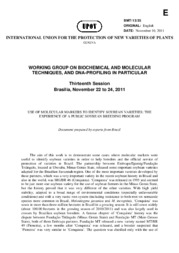Use of molecular markers to identify soybean varieties: the experience of a public soybean breeding program.
Use of molecular markers to identify soybean varieties: the experience of a public soybean breeding program.
Autoria: FRONZA, V.; ABDELNOOR, R. V.; ARIAS, C. A. A.; PACHECO, L. G. A.; ARANTES, N. E.; ZITO, R. K.; SÁ, M. E. L.
Resumo: The aim of this work is to demonstrate some cases where molecular markers were useful to identify soybean varieties in order to help breeders and the official service of protection of varieties in Brazil. The partnership between Embrapa/Epamig/Fundação Triângulo, located at Uberaba, Minas Gerais State, released some important soybean varieties adapted for the Brazilian Savannah region. One of the most important varieties developed by these partners, which was a very important variety in the recent soybean history in Brazil and also in the world, was MG/BR 46 (Conquista). ?Conquista? was released in 1995 and seemed to be just more one soybean variety for the use of soybean farmers in the Minas Gerais State, but the history proved that it was very different of the other varieties. With high yield stability, adapted to a broad range of environmental conditions (especially unfavourable conditions) and with a very rustic root system (including resistance to both root rot nematode species more common in Brazil, Meloidogyne javanica and M. incognita), ?Conquista? was sown in more than three million hectares in Brazil in a growing season. It is still sown widely (about 100.00 hectares in the growing season of 2010/2011) and was also largely used in crosses by Brazilian soybean breeders. A famous chapter of ?Conquista? history was the dispute between Fundação Triângulo (Minas Gerais State) and Fundação MT (Mato Grosso State), both of them Embrapa partners. Fundação MT released a new variety named MT/BR 49 (Pioneira), a few months after ?Conquista? was released, and a breeder suspected that ?Pioneira? was very similar to ?Conquista?. The question was clarified only with the use of BMT/13/25 page 2 molecular markers and the conclusion was that they presented the same genotype. Another history was that ?Conquista? was used to develop some RR (Roundup Ready) transgenic derived varieties (for example BRS Valiosa RR and BRS Favorita RR), and a problem of identification arose during the process of genetic seed production of BRS Valiosa RR and BRS Favorita RR, but in this case the SSR molecular markers used did not solve the problem. Another case of the use of molecular markers in Embrapa?s soybean breeding program developed by the partners of the Minas Gerais State is to clear a doubt about the origin of the variety BRSMG 800A, the first soybean Brazilian with brown tegument, and that was suspected to be a mutation for tegument color of the variety BRSMG 790A.
Ano de publicação: 2011
Tipo de publicação: Resumo em anais e proceedings
Unidade: Embrapa Soja
Palavras-chave: DNA, Marcador genético, Marcador molecular, Melhoramento genético vegetal, Soja
Observações
1 - Por padrão são exibidas publicações dos últimos 20 anos. Para encontrar publicações mais antigas, configure o filtro ano de publicação, colocando o ano a partir do qual você deseja encontrar publicações. O filtro está na coluna da esquerda na busca acima.
2 - Para ler algumas publicações da Embrapa (apenas as que estão em formato ePub), é necessário ter, no celular ou computador, um desses softwares gratuitos. Sistemas Android: Google Play Livros; IOS: iBooks; Windows e Linux: software Calibre.
Acesse outras publicações
Acesse a Base de Dados da Pesquisa Agropecuária (BDPA) para consultar o acervo completo das bibliotecas da Embrapa.

